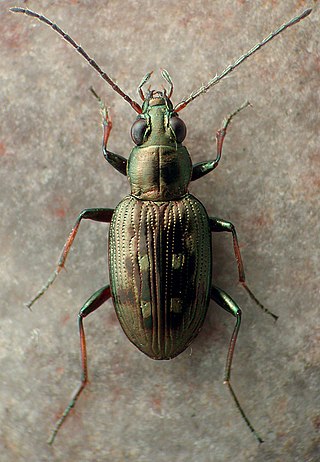
Setosphaeria rostrata is a heat tolerant fungus with an asexual reproductive form (anamorph) known as Exserohilum rostratum. This fungus is a common plant pathogen, causing leaf spots as well as crown rot and root rot in grasses. It is also found in soils and on textiles in subtropical and tropical regions. Exserohilum rostratum is one of the 35 Exserohilum species implicated uncommonly as opportunistic pathogens of humans where it is an etiologic agent of sinusitis, keratitis, skin lesions and an often fatal meningoencephalitis. Infections caused by this species are most often seen in regions with hot climates like Israel, India and the southern USA.
Solanum pseudoquina is a species of plant in the family Solanaceae. It is endemic to Brazil. A rare plant, it is dependent on conservation of its habitat to prevent it from becoming a threatened species.

Fungal meningitis refers to meningitis caused by a fungal infection.
Luttrellia is a genus of fungi in the family Halosphaeriaceae. The genus contains four species.
Setomelanomma is a genus of fungi in the family Phaeosphaeriaceae. This is a monotypic genus, containing the single species Setomelanomma holmiiM. Morelet (1980)

Monocerin is a dihydroisocoumarin and a polyketide metabolite that originates from various fungal species. It has been shown to display antifungal, plant pathogenic, and insecticidal characteristics. Monocerin has been isolated from Dreschlera monoceras, D. ravenelii, Exserohilum turcicum, and Fusarium larvarum.

Exserohilum is a genus of fungi in the family Pleosporaceae. The Exserohilum species are known for causing blight and human immune system diseases. The sexual reproductive states of Exserohilum species are known as Setosphaeria. The type species is Exserohilum turcicum. This genus is among three dematiaceous that are categorized for containing pathogens leading to diseases like phaeohyphomycosis.
Exserohilum antillanum is a species of fungus in the family Pleosporaceae. Found in Cuba growing on plant debris, it was described as new to science in 1995. The specific epithet antillanum refers to the Antillian sea, an old name for the Caribbean Sea. It is most similar in morphology to Exserohilum gedarefense, from which it differs in the size, pigmentation, and ornamentation of its conidia.
Exserohilum curvatum is a species of fungus in the family Pleosporaceae. Found in Venezuela, where it grows on the leaves of Sorghum, it was described as new to science in 1984. It differs from other Exserohilum species by its distinctly curved conidia.
Exserohilum echinochloae is a species of fungus in the family Pleosporaceae. Found in Bangladesh, where it grows on the leaves of Echinochloa colona, it was described as new to science in 1984. It is morphologically similar to Exserohilum monoceras and E. frumentacei, but differs from those species in its longer and wider conidia.
Exserohilum oryzicola is a species of fungus in the family Pleosporaceae. Found in Colombia, where it grows on the leaves of Oryza sativa, it was described as new to science in 1984. It is distinguished from other Exserohilum species by its longer and more tapered conidia.
Exserohilum oryzinum is a species of fungus in the family Pleosporaceae. Found in Egypt, where it grows on Oryza plants, it was described as new to science in 1984. It is distinguished from other Exserohilum by its distinctly curved to sigmoid (S-shaped) conidia.
Exserohilum heteropogonicola is a species of fungus in the family Pleosporaceae. Found in Uttarakhand, where it grows on the leaves of Heteropogon contortus, it was described as new to science in 1984. It has conidia that are cylindrical to fusoid (spindle-shaped), and often curved.
Exserohilum longirostratum is a species of fungus in the family Pleosporaceae. Found in India, it was described as new to science in 1957 as Helminthosporium longirostratum, and transferred to the genus Exserohilum in 1984.

Bembidion inaequale is a species of ground beetle in the family Carabidae. It is found in North America.

Oiceoptoma inaequale, the ridged carrion beetle, is a species of carrion beetle in the family Silphidae. It is found in North America.
Curvularia inaequalis is a plant saprobe that resides in temperate and subtropical environments. It is commonly found in the soils of forage grasses and grains. The species has been observed in a broad distribution of countries including Turkey, France, Canada, The United States, Japan and India. This species is dematiaceous and a hyphomycete.

Strongylacidon is a genus of sponges in the family Chondropsidae. The species of this genus are found in Southern Hemisphere.
Schizothecium inaequale is a species of coprophilous fungus in the family Lasiosphaeriaceae. It is known to grow in the dung of goats.






